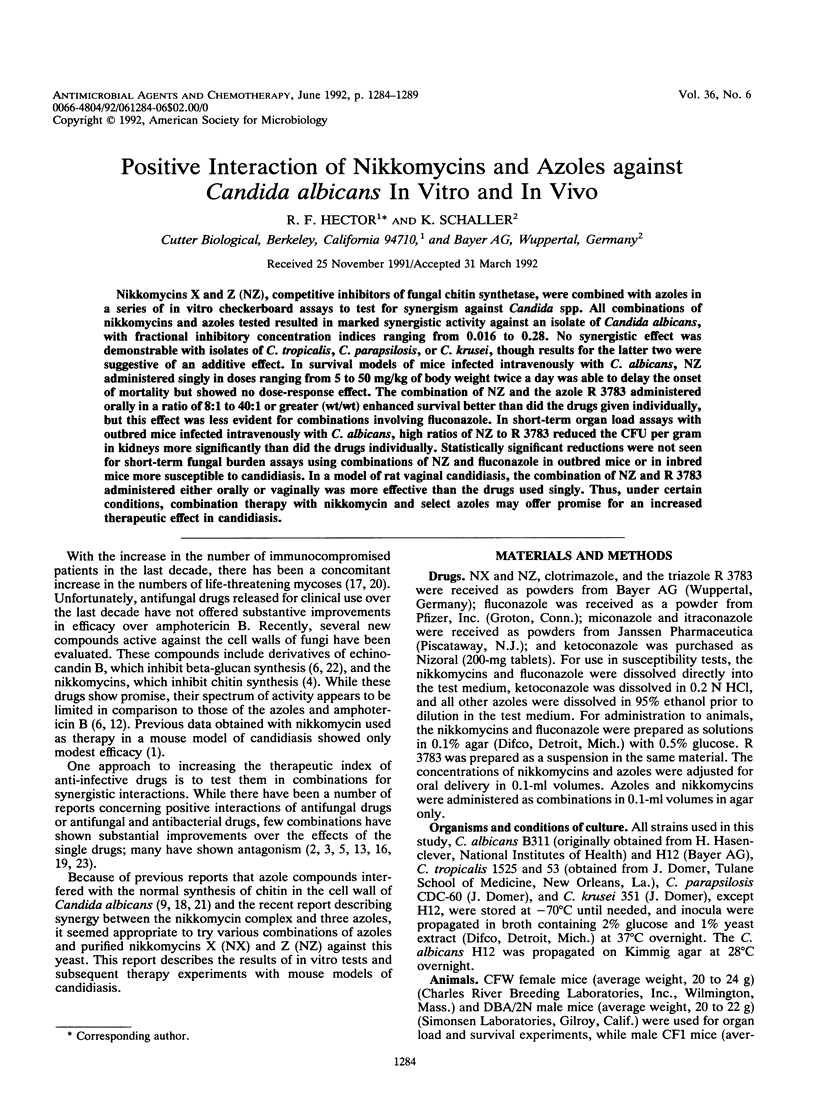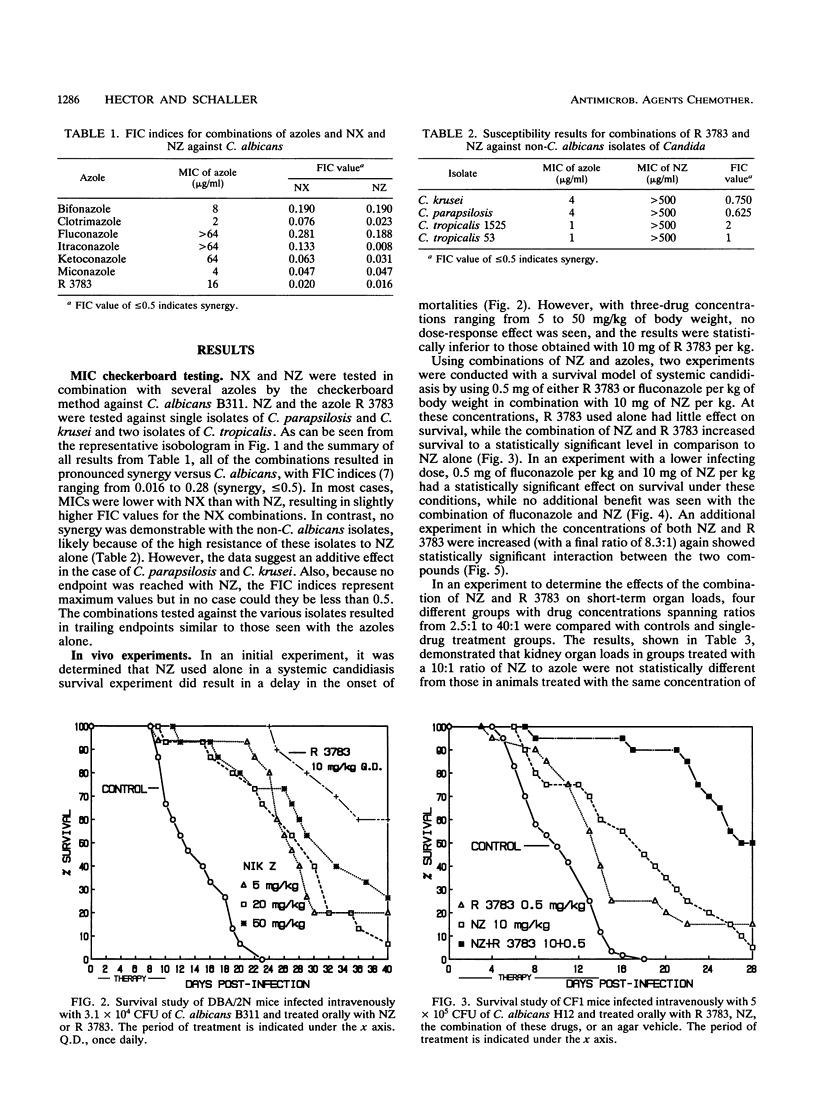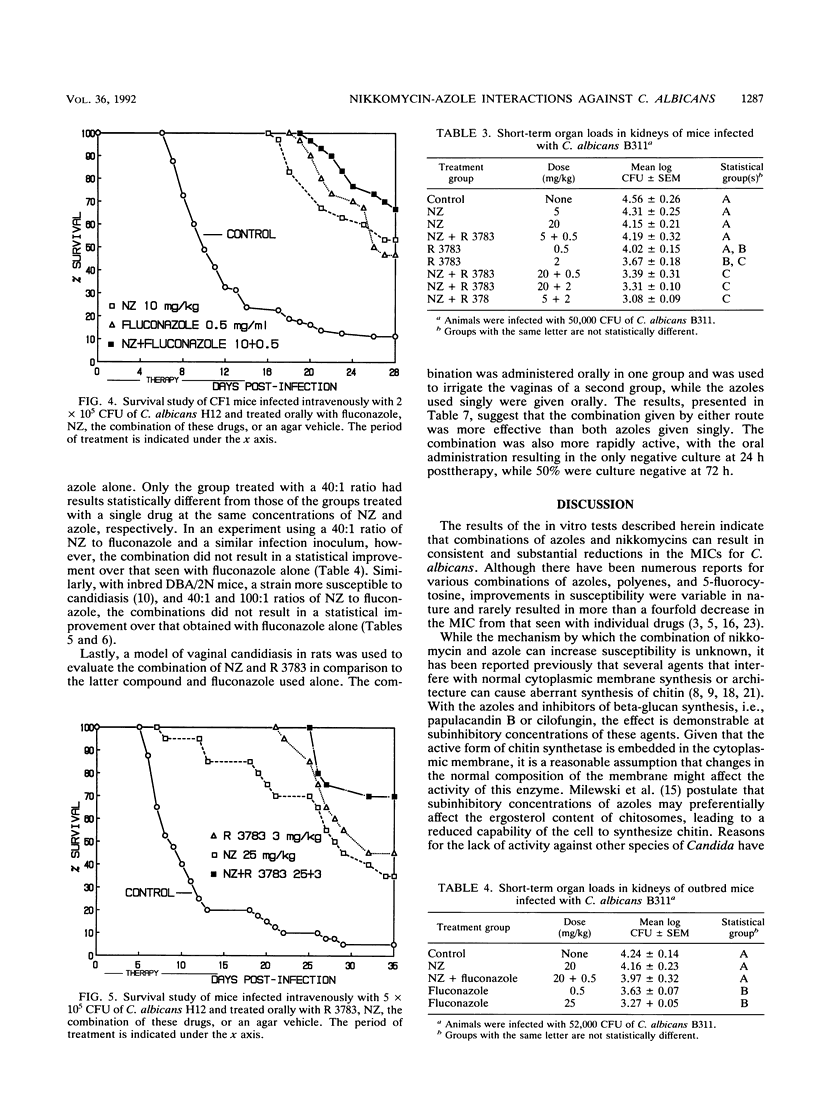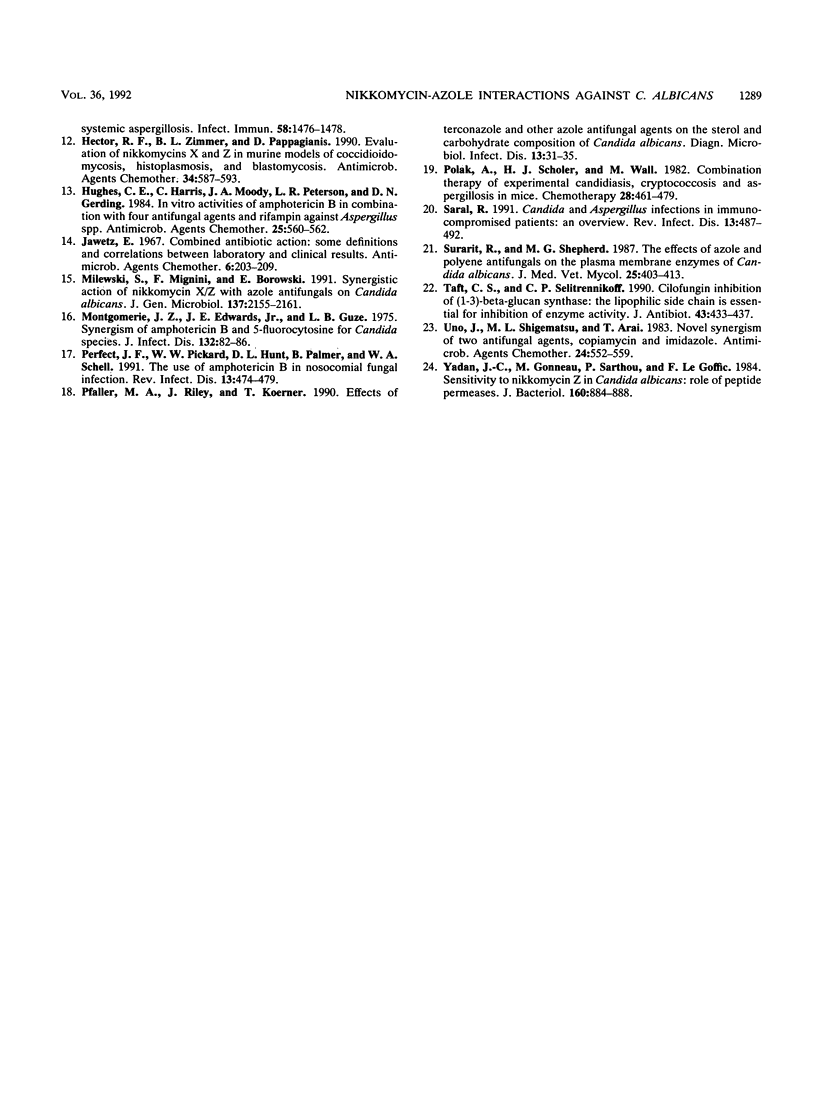Abstract
Nikkomycins X and Z (NZ), competitive inhibitors of fungal chitin synthetase, were combined with azoles in a series of in vitro checkerboard assays to test for synergism against Candida spp. All combinations of nikkomycins and azoles tested resulted in marked synergistic activity against an isolate of Candida albicans, with fractional inhibitory concentration indices ranging from 0.016 to 0.28. No synergistic effect was demonstrable with isolates of C. tropicalis, C. parapsilosis, or C. krusei, though results for the latter two were suggestive of an additive effect. In survival models of mice infected intravenously with C. albicans, NZ administered singly in doses ranging from 5 to 50 mg/kg of body weight twice a day was able to delay the onset of mortality but showed no dose-response effect. The combination of NZ and the azole R 3783 administered orally in a ratio of 8:1 to 40:1 or greater (wt/wt) enhanced survival better than did the drugs given individually, but this effect was less evident for combinations involving fluconazole. In short-term organ load assays with outbred mice infected intravenously with C. albicans, high ratios of NZ to R 3783 reduced the CFU per gram in kidneys more significantly than did the drugs individually. Statistically significant reductions were not seen for short-term fungal burden assays using combinations of NZ and fluconazole in outbred mice or in inbred mice more susceptible to candidiasis. In a model of rat vaginal candidiasis, the combination of NZ and R 3783 administered either orally or vaginally was more effective than the drugs used singly. Thus, under certain conditions, combination therapy with nikkomycin and select azoles may offer promise for an increased therapeutic effect in candidiasis.
Full text
PDF





Selected References
These references are in PubMed. This may not be the complete list of references from this article.
- Becker J. M., Marcus S., Tallock J., Miller D., Krainer E., Khare R. K., Naider F. Use of the chitin-synthesis inhibitor nikkomycin to treat disseminated candidiasis in mice. J Infect Dis. 1988 Jan;157(1):212–214. doi: 10.1093/infdis/157.1.212. [DOI] [PubMed] [Google Scholar]
- Brajtburg J., Kobayashi D., Medoff G., Kobayashi G. S. Antifungal action of amphotericin B in combination with other polyene or imidazole antibiotics. J Infect Dis. 1982 Aug;146(2):138–146. doi: 10.1093/infdis/146.2.138. [DOI] [PubMed] [Google Scholar]
- Corrado M. L., Kramer M., Cummings M., Eng R. H. Susceptibility of dermatiaceous fungi to amphotericin B, miconazole, ketoconazole, flucytosine and rifampin alone and in combination. Sabouraudia. 1982 Jun;20(2):109–113. doi: 10.1080/00362178285380181. [DOI] [PubMed] [Google Scholar]
- Dupont B., Drouhet E. In vitro synergy and antagonism of antifungal agents against yeast-like fungi. Postgrad Med J. 1979 Sep;55(647):683–686. doi: 10.1136/pgmj.55.647.683. [DOI] [PMC free article] [PubMed] [Google Scholar]
- Dähn U., Hagenmaier H., Höhne H., König W. A., Wolf G., Zähner H. Stoffwechselprodukte von mikroorganismen. 154. Mitteilung. Nikkomycin, ein neuer hemmstoff der chitinsynthese bei pilzen. Arch Microbiol. 1976 Mar 19;107(2):143–160. doi: 10.1007/BF00446834. [DOI] [PubMed] [Google Scholar]
- Gordee R. S., Zeckner D. J., Howard L. C., Alborn W. E., Jr, Debono M. Anti-Candida activity and toxicology of LY121019, a novel semisynthetic polypeptide antifungal antibiotic. Ann N Y Acad Sci. 1988;544:294–309. doi: 10.1111/j.1749-6632.1988.tb40415.x. [DOI] [PubMed] [Google Scholar]
- Hallander H. O., Dornbusch K., Gezelius L., Jacobson K., Karlsson I. Synergism between aminoglycosides and cephalosporins with antipseudomonal activity: interaction index and killing curve method. Antimicrob Agents Chemother. 1982 Nov;22(5):743–752. doi: 10.1128/aac.22.5.743. [DOI] [PMC free article] [PubMed] [Google Scholar]
- Hector R. F., Braun P. C. Synergistic action of nikkomycins X and Z with papulacandin B on whole cells and regenerating protoplasts of Candida albicans. Antimicrob Agents Chemother. 1986 Mar;29(3):389–394. doi: 10.1128/aac.29.3.389. [DOI] [PMC free article] [PubMed] [Google Scholar]
- Hector R. F., Yee E., Collins M. S. Use of DBA/2N mice in models of systemic candidiasis and pulmonary and systemic aspergillosis. Infect Immun. 1990 May;58(5):1476–1478. doi: 10.1128/iai.58.5.1476-1478.1990. [DOI] [PMC free article] [PubMed] [Google Scholar]
- Hector R. F., Yee E. Evaluation of Bay R 3783 in rodent models of superficial and systemic candidiasis, meningeal cryptococcosis, and pulmonary aspergillosis. Antimicrob Agents Chemother. 1990 Mar;34(3):448–454. doi: 10.1128/aac.34.3.448. [DOI] [PMC free article] [PubMed] [Google Scholar]
- Hector R. F., Zimmer B. L., Pappagianis D. Evaluation of nikkomycins X and Z in murine models of coccidioidomycosis, histoplasmosis, and blastomycosis. Antimicrob Agents Chemother. 1990 Apr;34(4):587–593. doi: 10.1128/aac.34.4.587. [DOI] [PMC free article] [PubMed] [Google Scholar]
- Hughes C. E., Harris C., Moody J. A., Peterson L. R., Gerding D. N. In vitro activities of amphotericin B in combination with four antifungal agents and rifampin against Aspergillus spp. Antimicrob Agents Chemother. 1984 May;25(5):560–562. doi: 10.1128/aac.25.5.560. [DOI] [PMC free article] [PubMed] [Google Scholar]
- Jawetz E. Combined antibiotic action: some definitions and correlations between laboratory and clinical results. Antimicrob Agents Chemother (Bethesda) 1967;7:203–209. doi: 10.1128/AAC.7.2.203. [DOI] [PubMed] [Google Scholar]
- Milewski S., Mignini F., Borowski E. Synergistic action of nikkomycin X/Z with azole antifungals on Candida albicans. J Gen Microbiol. 1991 Sep;137(9):2155–2161. doi: 10.1099/00221287-137-9-2155. [DOI] [PubMed] [Google Scholar]
- Montgomerie J. Z., Edwards J. E., Jr, Guze L. B. Synergism of amphotericin B and 5-fluorocytosine for candida species. J Infect Dis. 1975 Jul;132(1):82–86. doi: 10.1093/infdis/132.1.82. [DOI] [PubMed] [Google Scholar]
- Perfect J. R., Pickard W. W., Hunt D. L., Palmer B., Schell W. A. The use of amphotericin B in nosocomial fungal infection. Rev Infect Dis. 1991 May-Jun;13(3):474–479. doi: 10.1093/clinids/13.3.474. [DOI] [PubMed] [Google Scholar]
- Pfaller M. A., Riley J., Koerner T. Effects of terconazole and other azole antifungal agents on the sterol and carbohydrate composition of Candida albicans. Diagn Microbiol Infect Dis. 1990 Jan-Feb;13(1):31–35. doi: 10.1016/0732-8893(90)90050-6. [DOI] [PubMed] [Google Scholar]
- Polak A., Scholer H. J., Wall M. Combination therapy of experimental candidiasis, cryptococcosis and aspergillosis in mice. Chemotherapy. 1982;28(6):461–479. doi: 10.1159/000238138. [DOI] [PubMed] [Google Scholar]
- Saral R. Candida and Aspergillus infections in immunocompromised patients: an overview. Rev Infect Dis. 1991 May-Jun;13(3):487–492. doi: 10.1093/clinids/13.3.487. [DOI] [PubMed] [Google Scholar]
- Surarit R., Shepherd M. G. The effects of azole and polyene antifungals on the plasma membrane enzymes of Candida albicans. J Med Vet Mycol. 1987 Dec;25(6):403–413. doi: 10.1080/02681218780000491. [DOI] [PubMed] [Google Scholar]
- Taft C. S., Selitrennikoff C. P. Cilofungin inhibition of (1-3)-beta-glucan synthase: the lipophilic side chain is essential for inhibition of enzyme activity. J Antibiot (Tokyo) 1990 Apr;43(4):433–437. doi: 10.7164/antibiotics.43.433. [DOI] [PubMed] [Google Scholar]
- Uno J., Shigematsu M. L., Arai T. Novel synergism of two antifungal agents, copiamycin and imidazole. Antimicrob Agents Chemother. 1983 Oct;24(4):552–559. doi: 10.1128/aac.24.4.552. [DOI] [PMC free article] [PubMed] [Google Scholar]
- Yadan J. C., Gonneau M., Sarthou P., Le Goffic F. Sensitivity to nikkomycin Z in Candida albicans: role of peptide permeases. J Bacteriol. 1984 Dec;160(3):884–888. doi: 10.1128/jb.160.3.884-888.1984. [DOI] [PMC free article] [PubMed] [Google Scholar]


